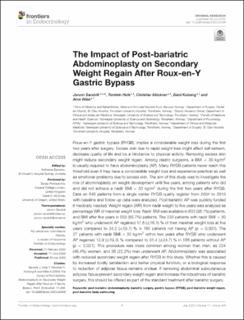| dc.contributor.author | Sandvik, Jorunn | |
| dc.contributor.author | Hole, Torstein | |
| dc.contributor.author | Kløckner, Christian | |
| dc.contributor.author | Kulseng, Bård Eirik | |
| dc.contributor.author | Wibe, Arne | |
| dc.date.accessioned | 2021-04-27T07:46:20Z | |
| dc.date.available | 2021-04-27T07:46:20Z | |
| dc.date.created | 2020-11-26T14:41:57Z | |
| dc.date.issued | 2020 | |
| dc.identifier.citation | Frontiers in Endocrinology. 2020, 11:459 1-8. | en_US |
| dc.identifier.issn | 1664-2392 | |
| dc.identifier.uri | https://hdl.handle.net/11250/2739777 | |
| dc.description.abstract | Roux-en-Y gastric bypass (RYGB), implies a considerable weight loss during the first two years after surgery. Excess skin due to rapid weight loss might affect self-esteem, decrease quality of life and be a hindrance to physical activity. Removing excess skin might reduce secondary weight regain. Among plastic surgeons, a BMI <30 kg/m2 is usually required to have abdominoplasty (AP). Many RYGB patients never reach this threshold even if they have a considerable weight loss and experience practical as well as emotional problems due to excess skin. The aim of this study was to investigate the role of abominoplasty on weight development until five years, among patients who did and did not achieve a nadir BMI <30 kg/m2 during the first two years after RYGB. Data on 645 patients from a single center RYGB-quality register from 2004 to 2013 with baseline and follow-up data were analyzed. Post-bariatric AP was publicly funded if medically needed. Weight regain (WR) from nadir weight to five years was analyzed as percentage WR of maximal weight loss. Nadir BMI was available in 633 (98.1%) patients, and BMI after five years in 553 (85.7%) patients. The 233 patients with nadir BMI <30 kg/m2 who underwent AP regained 17.8 (±16.1) % of their maximal weight loss at five years compared to 24.2 (±19.7) % in 185 patients not having AP (p < 0.001). The 27 patients with nadir BMI > 30 kg/m2 within two years after RYGB who underwent AP regained 12.9 (±19.3) % compared to 31.4 (±24.7) % in 188 patients without AP (p < 0.001). This procedure was more common among women than men, as 224 (46.4%) women, and 36 (22.2%) men underwent AP. Abdominoplasty was associated with reduced secondary weight regain after RYGB in this study. Whether this is caused by increased bodily satisfaction and better physical function, or a biological response to reduction of adipose tissue remains unclear. If removing abdominal subcutaneous adipose tissue prevent secondary weight regain and increase the robustness of bariatric surgery, this should be offered as part of the standard treatment after bariatric surgery. | en_US |
| dc.language.iso | eng | en_US |
| dc.publisher | Frontiers | en_US |
| dc.relation.uri | https://www.frontiersin.org/articles/10.3389/fendo.2020.00459/full | |
| dc.rights | Navngivelse 4.0 Internasjonal | * |
| dc.rights.uri | http://creativecommons.org/licenses/by/4.0/deed.no | * |
| dc.title | The Impact of Post-bariatric Abdominoplasty on Secondary Weight Regain After Roux-en-Y Gastric Bypass | en_US |
| dc.type | Peer reviewed | en_US |
| dc.type | Journal article | en_US |
| dc.description.version | publishedVersion | en_US |
| dc.source.pagenumber | 1-8 | en_US |
| dc.source.volume | 11:459 | en_US |
| dc.source.journal | Frontiers in Endocrinology | en_US |
| dc.identifier.doi | 10.3389/fendo.2020.00459 | |
| dc.identifier.cristin | 1853012 | |
| cristin.ispublished | true | |
| cristin.fulltext | original | |
| cristin.qualitycode | 1 | |

